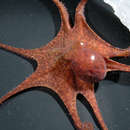Comprehensive Description
provided by Smithsonian Contributions to Zoology
Octopus oliveri (Berry, 1914)
DIAGNOSIS.—Animal small to medium-sized (“dorsal length of body” 27–30 mm (Berry, 1914b:136)). Mantle broad (MWI 103–137), pyriform, widest posteriorly; neck weakly constricted; head short, narrower than mantle (HWI 77–89); eyes elevated, with small, puckered openings. Arms short (ALI about 75), stout, tapering abruptly near tips, arm formula II = III > I = IV; proximal 4 suckers on each arm uniserial, suckers biserial distally. Web thick, shallow. Dorsal surface of mantle and head with numerous conical papillae; eye surrounded by circumocular ring of 5 to 6 low, individual papillae, supraocular papillae absent; ventral surface smooth. Color dark slate dorsally, lighter ventrally. Inner surface of suckers light brown to cream.
ORIGINAL DESCRIPTION.—Berry, 1914b:136, as Polypus oliveri.
TYPE LOCALITY.—Sunday Island, Kermadec Islands (intertidal among rocks).
TYPE.—Holotype: USNM 816455, female, 30 mm ML, SSB no. 405.
DISTRIBUTION.—In addition to the type locality, Okutani etal. (1987) attributed a specimen from Ishigaki Island, Okinawa, to this species.
- bibliographic citation
- Voss, N. A. and Sweeney, M. J. 1998. "Systematics and Biogeography of cephalopods. Volume II." Smithsonian Contributions to Zoology. 277-599. https://doi.org/10.5479/si.00810282.586.277

